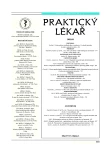The port and its role in oncological patients
Port a jeho úloha v léčbě onkologicky nemocných
Nutnost dlouhodobého vstupu do žilního řečiště vedla k vývoji systémů, které to umožní a současně minimalizují rizika související s implantací cizorodého materiálu. Vedle perkutánních kanyl s antibakteriální úpravou v nejrůznějších provedeních byl vyvinut systém uložený kompletně v podkoží – port. Tento systém našel využití i při permanentním vstupu do jiných dutých částí lidského těla, jako je arteriální řečiště, peritoneální dutina, epidurální prostor a další. Jeho využití je mnohostranné, bezpečné, při správném ošetřování dlouhodobé a především komfortní pro pacienta i lékaře.
Klíčová slova:
venózní port – intravenózní chemoterapie – Huberova jehla – portový systém – intraarte - riální port.
Authors:
M. Ondrák 1; Z. Kaplan 1; R. Šefr 1; I. Penka 1
; V. Fait 1; Z. Sýkorová 2
Authors‘ workplace:
Masarykův onkologický ústav
ředitel doc. MUDr. R. Vyzula, CSc.
; Oddělení chirurgické onkologie
primář MUDr. V. Chrenko, CSc.
1; Ambulantní část Kliniky komplexní onkologické péče
staniční sestra Z. Sýkorová
2
Published in:
Prakt. Lék. 2005; 85(12): 677-680
Category:
Reviews
Overview
The necessity of long-term entry into the venous blood bed has led to the development of systems that render that possible and simultaneously minimize risks connected with the implantation of alien material. Aside of antibacterially treated percutaneous canulae of various designs there has been developed a system placed completely in the subcutis - a port. This system has found its place in applications even in the permanent entry into other cavities of the human body such as the arterial blood bed, the peritoneal cavity, epidural spaces, etc. Its application is versatile, safe, long-term when properly tended to, and foremost comfortable for the patient as well as for the physician.
Key words:
venous port - intravenous chemotherapy - Huber’s needle - portal system - intra-arterial port
Labels
General practitioner for children and adolescents General practitioner for adultsArticle was published in
General Practitioner

2005 Issue 12
- Metamizole at a Glance and in Practice – Effective Non-Opioid Analgesic for All Ages
- Memantine in Dementia Therapy – Current Findings and Possible Future Applications
- Advances in the Treatment of Myasthenia Gravis on the Horizon
- Possibilities of Using Metamizole in the Treatment of Acute Primary Headaches
- Hope Awakens with Early Diagnosis of Parkinson's Disease Based on Skin Odor
Most read in this issue
- Malabsorption syndrome in children, its diagnostics and treatment692
- Idiopathic macular hole - epidemiology, classification, natural course, and therapy
- Hypoxia of the brain
- The port and its role in oncological patients
